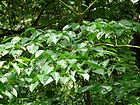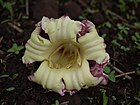Note: This is a project under development. The articles on this wiki are just being initiated and broadly incomplete. You can Help creating new pages.
Difference between revisions of "Oroxylum indicum - Shyonaka"
(Created page with "thumb|right|''Oroxylum indicum'', ''Shyonaka'' Shyonaka is a species of flowering plant belonging to the family Bignoniaceae, common...") |
|||
| (33 intermediate revisions by 3 users not shown) | |||
| Line 1: | Line 1: | ||
[[File:Oroxylum indicum W3 IMG 3170.jpg|thumb|right|''Oroxylum indicum'', ''Shyonaka'']] | [[File:Oroxylum indicum W3 IMG 3170.jpg|thumb|right|''Oroxylum indicum'', ''Shyonaka'']] | ||
| + | '''Shyonaka''' is a species of flowering plant belonging to the family Bignoniaceae. It is a tree which can reach a height of 12 metres. | ||
| + | ==Uses== | ||
| + | {{Uses|Wounds}}, {{Uses|Cuts}}, {{Uses|Snakebites}}, {{Uses|Curing liver disorders}}, {{Uses|Skin eruptions}}, {{Uses|Blotches}}, {{Uses|Pimples}}, {{Uses|Diarrhea}}, {{Uses|Sore throats}}.<ref name="Uses"/> | ||
| − | + | ===Food=== | |
| + | Oroxylum indicum can be used in Food. Flowers are cooked as vegetable. Unripe fruits are pickled.<ref name="Forest foods of Western Ghat"/> | ||
| − | == | + | ==Parts Used== |
| − | + | {{Parts Used|Roots}}, {{Parts Used|Leaves}}, {{Parts Used|Fruits}}, {{Parts Used|Seeds}} | |
| − | |||
| − | |||
| − | == | + | ==Chemical Composition== |
| + | Baicalein, oroxylin and pinostrobin along with one sterol, Stigmast.<ref name="chemical composition"/> | ||
| − | + | ==Common names== | |
| − | + | {{Common names|kn=Tattuna|ml=Palaqapayyani|sa=Aralu, Shyonaka|ta=Cori-konnai|te=Pampena|hi=Bhut-vriksha|en=Broken Bones Tree, Indian Trumpet Flower}} | |
| − | |||
| − | |||
| − | |||
| − | == References == | + | ==Properties== |
| − | + | Reference: Dravya - Substance, Rasa - Taste, Guna - Qualities, Veerya - Potency, Vipaka - Post-digesion effect, Karma - Pharmacological activity, Prabhava - Therepeutics. | |
| − | <references> | + | ===Dravya=== |
| − | <ref name=" | + | |
| − | <ref name=" | + | ===Rasa=== |
| + | Tikta (Bitter), Kashaya (Astringent), Madhura (Sweet0 | ||
| + | ===Guna=== | ||
| + | Laghu (Light), Ruksha (Dry) | ||
| + | ===Veerya=== | ||
| + | Ushna (Hot) | ||
| + | ===Vipaka=== | ||
| + | Katu (Pungent) | ||
| + | ===Karma=== | ||
| + | Kapha, Vata | ||
| + | ===Prabhava=== | ||
| + | |||
| + | ===Nutritional components=== | ||
| + | Oroxylum indicum Contains the Following nutritional components like - Vitamin-A, B and C; polyphenols baicalein, oroxylin A and chrysin, ursolic acid, benzoic acid; Tannins<ref name="Forest foods of Western Ghat"/>. | ||
| + | |||
| + | ==Habit== | ||
| + | {{Habit|Tree}} | ||
| + | |||
| + | ==Identification== | ||
| + | ===Leaf=== | ||
| + | {{Leaf|Compound|Triangular|2-3 pinnate, pinnae 5-9; imparipinnate, opposite; leaflets 3-5 in each pinnae, opposite, 7.5-15 x 4-9 cm, ovate, apex acuminate.}}<ref name="Leaf"/> | ||
| + | |||
| + | ===Flower=== | ||
| + | {{Flower|Bisexual|10cm long|Reddish-purple and pinkish-yellow|5|Flowers in terminal racemes, large, reddish-purple and pinkish-yellow within}} | ||
| + | |||
| + | ===Fruit=== | ||
| + | {{Fruit|Flat|30-90 cm long||Compressed, tapering at both ends|Seeds thin, papery, 5-6 cm long, winged all around except at base.}} | ||
| + | |||
| + | ===Other features=== | ||
| + | |||
| + | ==List of Ayurvedic medicine in which the herb is used== | ||
| + | *[[Citraka Harītakī]] | ||
| + | *[[Dasamoolarishtam]] | ||
| + | *[[Dhanvantaram tailam]] | ||
| + | *[[Dhanvantararishtam]] | ||
| + | <ref name="Ayurvedic preparations"/> | ||
| + | |||
| + | ==Where to get the saplings== | ||
| + | ==Mode of Propagation== | ||
| + | {{Propagation|Seeds}}, {{Propagation|Cuttings}}. | ||
| + | |||
| + | ==How to plant/cultivate== | ||
| + | Seed is the best propagation material and should be collected before split- ting of pods during February–March. Seed germination percentage is 80%–90% without any pretreatment<ref name="How to plant/cultivate"/>. Oroxylum indicum is available through June to December<ref name="Forest foods of Western Ghat"/>. | ||
| + | |||
| + | ==Commonly seen growing in areas== | ||
| + | {{Commonly seen|Tropical area}}, {{Commonly seen|Borders of forests and fields}}. | ||
| + | |||
| + | ==Photo Gallery== | ||
| + | <gallery class="left" caption="" widths="140px" heights="140px"> | ||
| + | Oroxylum indicum (2768007246).jpg | ||
| + | Oroxylum indicum (2768009112).jpg | ||
| + | Oroxylum indicum (7408745116).jpg | ||
| + | Oroxylum indicum (Arbre de Damoclès) MHNT.BOT.2007.26.56.jpg | ||
| + | Oroxylum indicum 02.JPG | ||
| + | </gallery> | ||
| + | |||
| + | ==References== | ||
| + | <references> | ||
| + | <ref name="chemical composition">[https://www.nepjol.info/index.php/SW/article/view/3852 Chemical constituents]</ref> | ||
| + | <ref name="Leaf">[https://indiabiodiversity.org/species/show/16688 Morphology]</ref> | ||
| + | <ref name="Ayurvedic preparations">[https://easyayurveda.com/2014/07/22/sona-patha-oroxylum-indicum-benefits-side-effects-research/ Ayurvedic preparations]</ref> | ||
| + | <ref name="How to plant/cultivate">[http://vikaspedia.in/agriculture/crop-production/package-of-practices/medicinal-and-aromatic-plants/oroxylum-indicum Cultivation details]</ref> | ||
| + | <ref name="Uses">Karnataka Aushadhiya Sasyagalu By Dr.Maagadi R Gurudeva, Page no:161</ref> | ||
| + | <ref name="Forest foods of Western Ghat">"Forest food for Northern region of Western Ghats" by Dr. Mandar N. Datar and Dr. Anuradha S. Upadhye, Page No.121, Published by Maharashtra Association for the Cultivation of Science (MACS) Agharkar Research Institute, Gopal Ganesh Agarkar Road, Pune</ref> | ||
</references> | </references> | ||
| − | == External Links == | + | ==External Links== |
| − | + | * [https://www.ncbi.nlm.nih.gov/pmc/articles/PMC3336262/ Phytochemical and antimicrobial study of Oroxylum indicum] | |
| − | [https:// | + | * [https://www.researchgate.net/publication/273990119_Chemical_constituents_from_Oroxylum_indicum_L_Kurz_of_Nepalese_Origin CHEMICAL CONSTITUENTS FROM OROXYLUM INDICUM] |
| + | *[http://bioinfo.bisr.res.in/project/domap/plant_details.php?plantid=0091&bname=Oroxylum%20indicum Oroxylum indicum on database of medicinal plants and automatic plants] | ||
| + | * [http://www.flowersofindia.net/catalog/slides/Broken%20Bones%20Tree.html Oroxylum indicum on flowers of india] | ||
[[Category:Herbs]] | [[Category:Herbs]] | ||
| + | [[Category:Ayurvedic herbs that don't have seed photos]] | ||
| + | [[Category:Bignoniaceae]] | ||
Latest revision as of 17:46, 15 November 2021
Shyonaka is a species of flowering plant belonging to the family Bignoniaceae. It is a tree which can reach a height of 12 metres.
Contents
- 1 Uses
- 2 Parts Used
- 3 Chemical Composition
- 4 Common names
- 5 Properties
- 6 Habit
- 7 Identification
- 8 List of Ayurvedic medicine in which the herb is used
- 9 Where to get the saplings
- 10 Mode of Propagation
- 11 How to plant/cultivate
- 12 Commonly seen growing in areas
- 13 Photo Gallery
- 14 References
- 15 External Links
Uses
Wounds, Cuts, Snakebites, Curing liver disorders, Skin eruptions, Blotches, Pimples, Diarrhea, Sore throats.[1]
Food
Oroxylum indicum can be used in Food. Flowers are cooked as vegetable. Unripe fruits are pickled.[2]
Parts Used
Chemical Composition
Baicalein, oroxylin and pinostrobin along with one sterol, Stigmast.[3]
Common names
| Language | Common name |
|---|---|
| Kannada | Tattuna |
| Hindi | Bhut-vriksha |
| Malayalam | Palaqapayyani |
| Tamil | Cori-konnai |
| Telugu | Pampena |
| Marathi | NA |
| Gujarathi | NA |
| Punjabi | NA |
| Kashmiri | NA |
| Sanskrit | Aralu, Shyonaka |
| English | Broken Bones Tree, Indian Trumpet Flower |
Properties
Reference: Dravya - Substance, Rasa - Taste, Guna - Qualities, Veerya - Potency, Vipaka - Post-digesion effect, Karma - Pharmacological activity, Prabhava - Therepeutics.
Dravya
Rasa
Tikta (Bitter), Kashaya (Astringent), Madhura (Sweet0
Guna
Laghu (Light), Ruksha (Dry)
Veerya
Ushna (Hot)
Vipaka
Katu (Pungent)
Karma
Kapha, Vata
Prabhava
Nutritional components
Oroxylum indicum Contains the Following nutritional components like - Vitamin-A, B and C; polyphenols baicalein, oroxylin A and chrysin, ursolic acid, benzoic acid; Tannins[2].
Habit
Identification
Leaf
| Kind | Shape | Feature |
|---|---|---|
| Compound | Triangular | 2-3 pinnate, pinnae 5-9; imparipinnate, opposite; leaflets 3-5 in each pinnae, opposite, 7.5-15 x 4-9 cm, ovate, apex acuminate. |
Flower
| Type | Size | Color and composition | Stamen | More information |
|---|---|---|---|---|
| Bisexual | 10cm long | Reddish-purple and pinkish-yellow | 5 | Flowers in terminal racemes, large, reddish-purple and pinkish-yellow within |
Fruit
| Type | Size | Mass | Appearance | Seeds | More information |
|---|---|---|---|---|---|
| Flat | 30-90 cm long | Compressed, tapering at both ends | Seeds thin, papery, 5-6 cm long, winged all around except at base. | {{{6}}} |
Other features
List of Ayurvedic medicine in which the herb is used
Where to get the saplings
Mode of Propagation
How to plant/cultivate
Seed is the best propagation material and should be collected before split- ting of pods during February–March. Seed germination percentage is 80%–90% without any pretreatment[6]. Oroxylum indicum is available through June to December[2].
Commonly seen growing in areas
Tropical area, Borders of forests and fields.
Photo Gallery
References
- ↑ Karnataka Aushadhiya Sasyagalu By Dr.Maagadi R Gurudeva, Page no:161
- ↑ 2.0 2.1 2.2 "Forest food for Northern region of Western Ghats" by Dr. Mandar N. Datar and Dr. Anuradha S. Upadhye, Page No.121, Published by Maharashtra Association for the Cultivation of Science (MACS) Agharkar Research Institute, Gopal Ganesh Agarkar Road, Pune
- ↑ Chemical constituents
- ↑ Morphology
- ↑ Ayurvedic preparations
- ↑ Cultivation details
External Links
- Ayurvedic Herbs known to be helpful to treat Wounds
- Ayurvedic Herbs known to be helpful to treat Cuts
- Ayurvedic Herbs known to be helpful to treat Snakebites
- Ayurvedic Herbs known to be helpful to treat Curing liver disorders
- Ayurvedic Herbs known to be helpful to treat Skin eruptions
- Ayurvedic Herbs known to be helpful to treat Blotches
- Ayurvedic Herbs known to be helpful to treat Pimples
- Ayurvedic Herbs known to be helpful to treat Diarrhea
- Ayurvedic Herbs known to be helpful to treat Sore throats
- Herbs with Roots used in medicine
- Herbs with Leaves used in medicine
- Herbs with Fruits used in medicine
- Herbs with Seeds used in medicine
- Herbs with common name in Kannada
- Herbs with common name in Hindi
- Herbs with common name in Malayalam
- Herbs with common name in Tamil
- Herbs with common name in Telugu
- Herbs with common name in Sanskrit
- Herbs with common name in English
- Habit - Tree
- Index of Plants which can be propagated by Seeds
- Index of Plants which can be propagated by Cuttings
- Herbs that are commonly seen in the region of Tropical area
- Herbs that are commonly seen in the region of Borders of forests and fields
- Herbs
- Ayurvedic herbs that don't have seed photos
- Bignoniaceae





